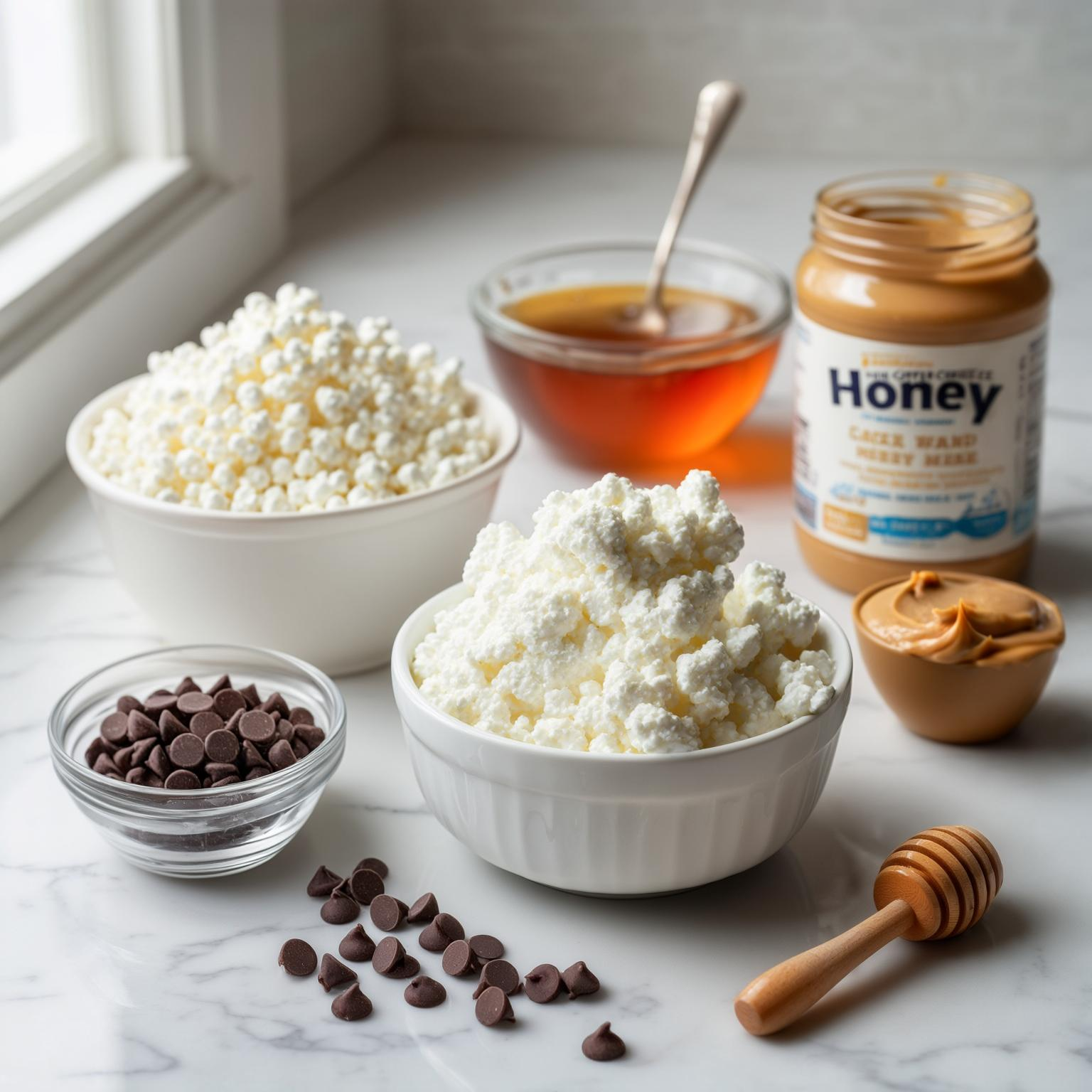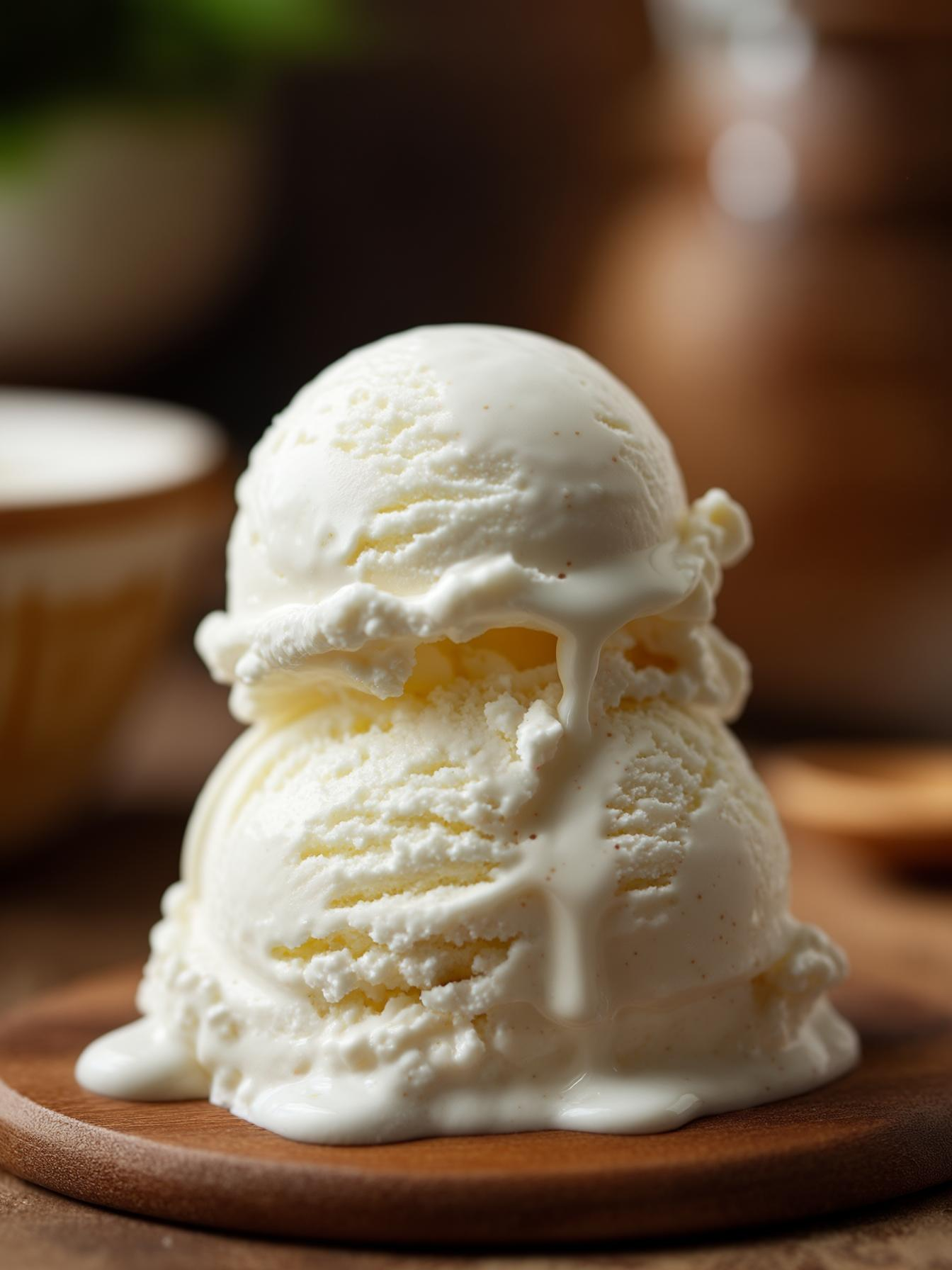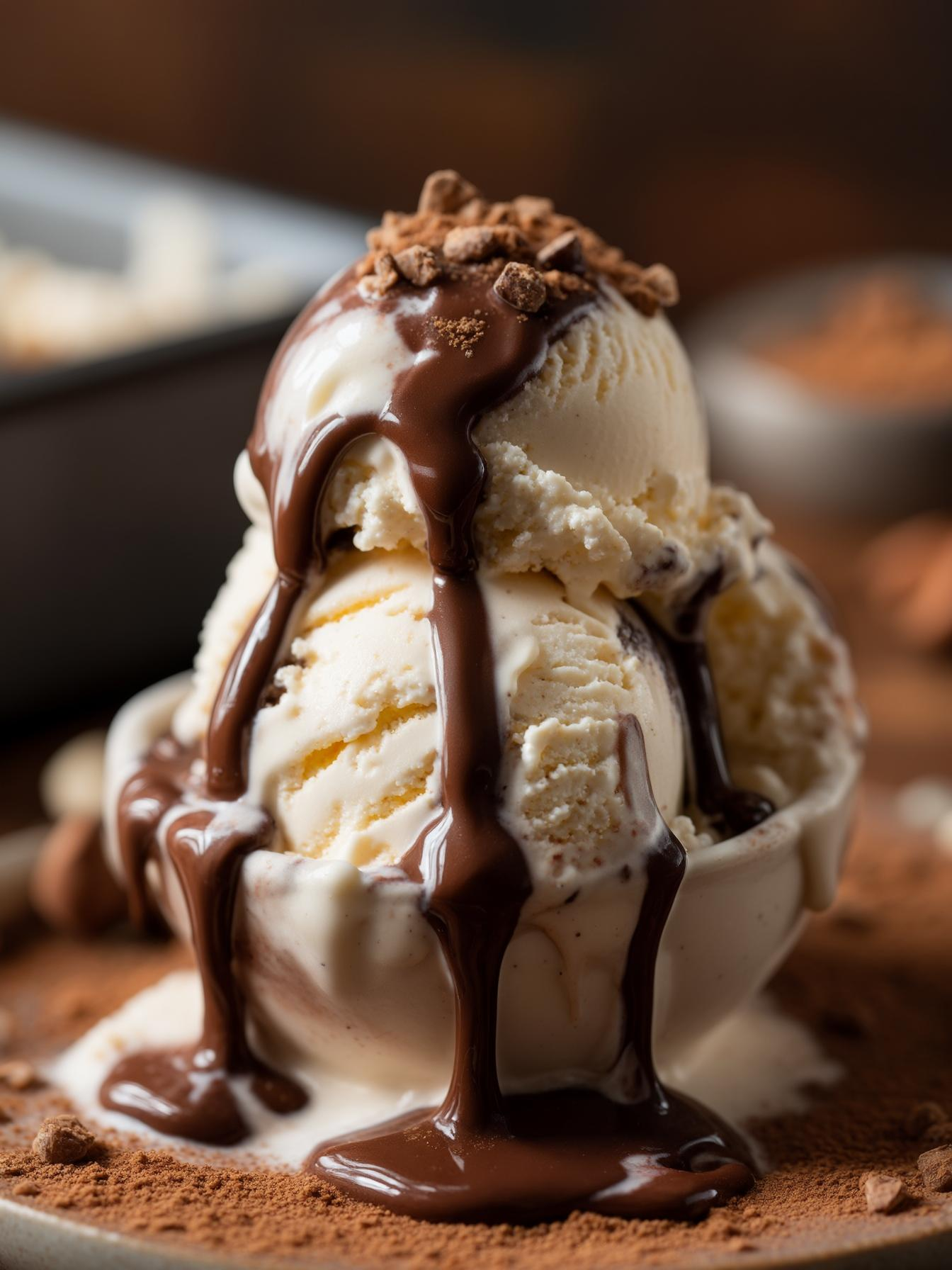Introduction
Cottage Cheese Ice Cream is a viral high-protein dessert that’s taking the internet by storm – and for good reason. Made with just four simple ingredients, this creamy treat offers all the indulgence of traditional ice cream with a nutritious twist. Blending cottage cheese into ice cream might sound unusual, but it creates a thick, creamy texture and adds a hefty dose of protein (over 20 grams per serving!). Whether you’re looking for a healthier alternative to satisfy your sweet tooth or a fun new recipe to add to your list of healthy desserts and low-carb snacks, this cottage cheese ice cream has you covered.
Why You’ll Love This Cottage Cheese Ice Cream
A bowl of creamy homemade cottage cheese ice cream studded with chocolate chips. This recipe has become wildly popular because it hits the sweet spot between healthy and delicious. Here are a few reasons you’ll love it:

Cottage Cheese Ice Cream Recipe
- Total Time: 10 minutes
- Yield: 4 servings
- Diet: Low Calorie
Description
You only need 4 simple ingredients to make this viral cottage cheese ice cream! It’s super creamy, thick and packed with over 20 grams of protein!
Ingredients
- 2 cups (16 oz) full fat cottage cheese, I used Good Culture
- ¼ cup honey
- 2 Tablespoons peanut butter
- 2 Tablespoons chocolate chips
Instructions
- Add cottage cheese, honey and peanut butter to a food processor or high powered blender and pulse/process until smooth and creamy.
- Stir in chocolate chips.
- Add mixture back into the cottage cheese container or a loaf pan and place in the freezer for about 4 hours, or until hard.
- Remove from the freezer, let thaw for 5-10 minutes, just until you can easily scoop it. Use an ice cream scoop to scoop into bowls and enjoy.
- Prep Time: 10 minutes
- Cuisine: American
Nutrition
- Serving Size: 3
- Calories: 284kcal
- Sugar: 27g
- Sodium: 483mg
- Fat: 12g
- Saturated Fat: 4g
- Protein: 22g
- Cholesterol: 20mg
Keywords: cottage cheese ice cream
- High-Protein & Healthy: Each serving is packed with protein thanks to cottage cheese, making it a more filling option than regular ice cream. It’s also lower in refined sugar, using natural honey as a sweetener and even offering some fiber and healthy fats from peanut butter and chocolate chips.
- Easy 4-Ingredient Recipe: You only need four simple ingredients to whip up this recipe, and no ice cream maker is required. It’s a quick blend-and-freeze process that anyone can do in minutes.
- Creamy & Delicious: Despite being made from cottage cheese, the texture is surprisingly smooth and creamy (no noticeable curds!). The flavor is like a rich cheesecake-meets-ice-cream, and you can customize it with your favorite mix-ins to suit your cravings.
- Versatile & Customizable: This base recipe is endlessly adaptable – you can create different flavor variations (think chocolate, fruit swirls, or coffee) to make your perfect ice cream. It’s a guilt-free frozen treat you’ll love as a dessert or even a post-workout snack.
Nutritional Benefits of Cottage Cheese Ice Cream
Using cottage cheese as the star ingredient means this ice cream isn’t just a dessert – it’s also nutritionally beneficial. Cottage cheese is loaded with protein (a one-cup serving contains around 20–25 grams of protein) and is a good source of calcium, B vitamins, and phosphorus. By turning it into ice cream, you’re getting a treat that can help keep you satisfied longer and support muscle maintenance and blood sugar balance. Unlike traditional ice creams that are high in sugar and low in protein, this recipe provides a better macronutrient balance. Each serving of this cottage cheese ice cream has roughly 20+ grams of protein, moderate carbs from the honey and any add-ins, and healthy fats from peanut butter. Plus, if you include mix-ins like dark chocolate or fruit, you get extra antioxidants and fiber. In short, you can indulge your cravings with a dessert that also nourishes your body – truly the best of both worlds!
Ingredients for Cottage Cheese Ice Cream

To make this cottage cheese ice cream, you’ll need just four main ingredients:
- Cottage Cheese: This is the creamy base of the ice cream. Full-fat cottage cheese will yield the creamiest result (thanks to the higher fat content), but low-fat cottage cheese can also work if you prefer. The cottage cheese provides the rich texture and high protein content. (Tip: Choose a brand of cottage cheese with a smooth consistency and no added flavors. If possible, opt for an organic brand without excessive salt.)
- Honey: A natural sweetener that blends perfectly with cottage cheese. Honey adds just the right amount of sweetness and keeps this recipe free of refined sugar. You can substitute with pure maple syrup or agave nectar if you like. For a lower-sugar option, a liquid stevia or monk fruit sweetener could work as well.
- Peanut Butter: This brings a nutty flavor and contributes extra creaminess (along with a boost of protein and healthy fats). Peanut butter makes the ice cream taste almost like a peanut butter cheesecake. If you have an allergy or don’t enjoy peanut butter, feel free to swap it with almond butter, cashew butter, or even sunflower seed butter. The nut/seed butter not only adds flavor but also helps improve the texture of the ice cream.
- Chocolate Chips: A handful of chocolate chips add delicious chocolatey bites throughout the ice cream. You can use dark chocolate chips, semi-sweet, or even sugar-free chocolate chips. For a lower sugar content, choose a brand sweetened with stevia or erythritol. If you prefer, you can replace the chocolate chips with cacao nibs or leave them out entirely – it’s up to you.
Optional Add-Ins: A pinch of salt can enhance the flavors, and a splash of pure vanilla extract can give an extra depth of classic ice cream flavor. These aren’t required, but a dash of vanilla or a sprinkle of cinnamon can be great if you want to experiment with the taste.
How to Make Cottage Cheese Ice Cream
Making this cottage cheese ice cream is as easy as blend and freeze. No fancy equipment or churning needed!
- Blend the Base: In a high-speed blender or food processor, combine the cottage cheese, honey, and peanut butter. Blend on high until the mixture is completely smooth and creamy. Make sure no lumps remain – you want the cottage cheese fully pureed so the “ice cream” will have a velvety texture. (Tip: Stop and scrape down the sides of the blender as needed to ensure everything is incorporated.) Once smooth, add the chocolate chips and either pulse a couple of times or simply stir them in. You don’t want to blend the chips (they’ll break up too much); just mix them so they’re evenly distributed throughout the mixture.
- Freeze: Transfer the blended cottage cheese mixture into a freezer-safe container. You can use the original cottage cheese tub (how convenient!), a loaf pan, or any airtight container. Smooth out the top of the mixture. For best results and to prevent iciness, press a piece of plastic wrap or parchment paper directly on the surface of the ice cream before sealing the container – this helps prevent ice crystals from forming on top. Place the container in the freezer and let it freeze for about 4 hours, or until the ice cream is firm.
- Serve: When you’re ready to enjoy your cottage cheese ice cream, take the container out of the freezer and let it sit at room temperature for 5–10 minutes. This slight thaw makes it much easier to scoop (since homemade protein ice creams can freeze quite hard). Use an ice cream scoop to serve into bowls or cones. Add your favorite toppings and dig in! You’ll be amazed at how creamy and scoopable it is, considering it’s made from cottage cheese.
Tips for the Best Results: For an even creamier texture, you can occasionally stir the ice cream as it freezes (for example, give it a good mix every 30 minutes for the first 2 hours) to break up ice crystals – this mimics the effect of churning and can help reduce iciness. Using full-fat cottage cheese and including the peanut butter (as this recipe does) also improves the creamy consistency. If you want to take it up a notch, you could even fold in a few tablespoons of whipped heavy cream into the blended mixture before freezing to add extra richness and volume (totally optional, but it can make the texture even closer to traditional ice cream). The base recipe itself should turn out thick and creamy if blended well and allowed to soften slightly before serving.
Flavor Variations and Mix-In Ideas
One of the best things about this cottage cheese ice cream recipe is how easy it is to customize. Once you have the basic base (cottage cheese + sweetener), you can get creative and make all sorts of flavors. Here are some delicious variation ideas to try:
- Chocolate Lovers: Blend 1–2 tablespoons of unsweetened cocoa powder into the base mixture to create a chocolate-flavored cottage cheese ice cream. You can also boost the chocolate factor by adding extra chocolate chips or swirling in a bit of melted dark chocolate before freezing.
- Strawberry Swirl (or Other Fruits): Blend a handful of fresh or frozen strawberries with the cottage cheese base for a fruity twist. After blending, fold in some chopped strawberries or swirl in a couple of tablespoons of strawberry jam before freezing. (Strawberry cottage cheese ice cream ends up tasting like strawberry cheesecake – yum!) This method works with other fruits too: blueberries, mango, peaches, or cherries.
- Peanut Butter & Banana: For an Elvis-inspired treat, blend in half of a ripe banana with the cottage cheese, honey, and peanut butter. The banana adds natural sweetness and extra creaminess. You can stir in a few crushed walnuts or pecans for texture. The result is like a frozen peanut butter banana pie.
- Mocha Espresso: Dissolve 1 teaspoon of instant espresso powder in a tablespoon of hot water and blend it into the cottage cheese mixture to infuse a coffee flavor. Combine this with the cocoa powder from the chocolate variation to make it a mocha-flavored ice cream. A pinch of cinnamon can be added to complement the coffee notes.
- Vanilla Bean: Keep it simple by adding 1–2 teaspoons of pure vanilla extract (or the seeds from a vanilla bean) to the base. This enhances the sweetness and gives a classic vanilla ice cream vibe – perfect for topping with anything from fresh fruit to a drizzle of chocolate sauce.
- Cinnamon Spice: Mix in 1/2 teaspoon of ground cinnamon (or pumpkin pie spice) into the blended base. This gives the ice cream a warm, spiced flavor – think along the lines of a snickerdoodle or chai-spiced ice cream. It pairs wonderfully with a honey drizzle on top.
- Cookies & Cream: After blending the base until smooth, fold in a few crushed chocolate sandwich cookies (or a healthier cookie alternative) before freezing. You’ll get a high-protein take on cookies & cream ice cream.
Feel free to get creative with mix-ins, but try not to add too much extra liquid (like thin syrups) as that could alter the freezing process and texture. Solid add-ins or thick swirls (nut butters, jams) tend to work best. The possibilities are endless, so have fun inventing your own cottage cheese ice cream flavors!

Storage Tips
Homemade cottage cheese ice cream is best enjoyed within a couple of weeks for optimal taste and texture. Here are some tips for storing it and maintaining that creamy consistency:
- Freeze in an Airtight Container: Keep the ice cream in a freezer-safe, airtight container when storing it. As mentioned above, pressing a piece of plastic wrap or wax paper directly on the surface of the ice cream before sealing the container will help prevent ice crystals and freezer burn. This extra step keeps your ice cream as creamy as possible.
- Use Within 1–2 Weeks: For the best flavor and texture, try to enjoy your cottage cheese ice cream within about two weeks of making it. It can technically be stored longer (it won’t spoil in the freezer), but after a couple of weeks you might notice more ice crystals or a slight change in taste/texture. Luckily, with how tasty this is, it rarely lasts that long!
- Thaw Briefly Before Serving: When you’re ready to eat, let the container sit out at room temperature for about 5–10 minutes. Because this ice cream doesn’t have the softening additives of commercial ice cream, it can freeze very solid. A short thaw makes it easier to scoop and gives you a smoother, creamier bite. Avoid leaving it out too long, though – you don’t want it fully melted.
- No Refreezing Melted Ice Cream: Try to only scoop out what you plan to eat in one sitting. If the ice cream melts significantly, refreezing it can cause a loss of the creamy texture and create larger ice crystals. If you do accidentally let it melt, you can still refreeze it safely, but the texture will not be as smooth. It’s best to enjoy it while it’s at the perfect semi-frozen consistency.
By following these storage tips, you’ll ensure each scoop of your cottage cheese ice cream is as delicious and creamy as the first!
Conclusion & Call to Action
Creamy, nourishing, and unbelievably simple, this Cottage Cheese Ice Cream recipe is a game-changer for healthy homemade desserts. It allows you to indulge in a frozen treat while sticking to your wellness goals – a total win-win! The next time you’re craving ice cream, skip the store-bought pint and try this high-protein, low-sugar alternative instead. You’ll love the satisfaction of knowing it’s made with wholesome ingredients and none of the guilt.
Ready to give it a whirl? Go grab that blender and a tub of cottage cheese, and start creating your own cottage cheese ice cream! If you try this recipe, let us know how you liked it – leave a comment and a star rating ⭐ to share your feedback. We’d love to hear about your favorite flavor variations or any creative twists you add. And if you’re looking for more guilt-free sweet treats, be sure to check out our other healthy desserts and low-carb snacks for inspiration. Enjoy your homemade ice cream!

Cottage Cheese Ice Cream FAQs
To cover all your curiosities, here are answers to some common questions about cottage cheese ice cream:
Q: Can you use cottage cheese in ice cream?
A: Yes, absolutely! Using cottage cheese in ice cream is the key to this recipe’s high-protein, creamy result. When blended, cottage cheese becomes smooth and thick, creating a rich base that mimics the texture of traditional ice cream (almost like a blended cheesecake). It’s a clever hack to make a frozen treat without needing heavy cream or eggs. Cottage cheese has a mild flavor that easily takes on the taste of whatever sweeteners or mix-ins you add (like honey, peanut butter, or fruit), so the end result doesn’t actually taste like tangy cottage cheese – it just tastes like delicious ice cream. In short, you can definitely use cottage cheese to make ice cream, and it’s a wonderful way to boost the protein and nutrition in your dessert.
Q: Why is my cottage cheese ice cream icy?
A: If your cottage cheese ice cream turned out icy or hard, a few factors could be at play. Cottage cheese has a high water content, and when you freeze it without churning, larger ice crystals can form (leading to an icy texture). To minimize iciness, make sure you used full-fat cottage cheese – the extra fat helps keep the mixture creamy. Adding ingredients like peanut butter (or a splash of cream) also increases the fat content and improves texture. Another important step is blending the mixture until completely smooth; any remaining curd bits or liquid pockets might freeze into ice bits. Also, remember to cover the ice cream’s surface with plastic wrap in the freezer and, if possible, stir the mixture once or twice during the initial freeze period to break up ice formation. Lastly, be sure to let the ice cream soften for a few minutes at room temp before scooping – if you try to scoop it rock-solid, it can feel icier. With these tips, your cottage cheese ice cream should come out creamy, not icy. (If all else fails and it’s still a bit icy, you can let it soften a tad more or even re-blend it before eating.)
Q: What is the healthiest ice cream you can eat?
A: The “healthiest” ice cream is one that satisfies your sweet tooth while aligning with your nutritional goals. In general, a healthier ice cream will be lower in added sugar and higher in beneficial nutrients (like protein or fiber) compared to regular ice cream. Some of the top choices include homemade frozen desserts like banana nice cream (made from blended frozen bananas) or Greek yogurt-based ice creams and popsicles. This cottage cheese ice cream is also one of the healthiest ice cream alternatives you can enjoy – it’s high in protein, contains natural sweetener instead of refined sugar, and is made from whole foods. There are also store-bought light ice creams and protein ice creams (for example, brands that are lower in calories and sugar, or dairy-free options made from almond or coconut milk), but be sure to read the labels, as some replace sugar with artificial sweeteners or have long ingredient lists. Ultimately, the healthiest ice cream is one with simple ingredients, moderate sugar, and some nutritional value. Cottage cheese ice cream checks those boxes, making it a smart choice for a healthy indulgence.
Q: Does cottage cheese freeze well?
A: Cottage cheese can be frozen, but its texture will change in the process. If you freeze plain cottage cheese in its container and then thaw it, you’ll likely notice it becomes watery or a bit grainy as the curds separate from the liquid. This texture isn’t very appetizing for eating plain, which is why people don’t usually snack on thawed cottage cheese by itself. However, cottage cheese freezes very well when it’s used in recipes where it’s blended or cooked. For example, in this cottage cheese ice cream recipe, we blend the cottage cheese until smooth before freezing, which results in a creamy, uniform texture in the finished ice cream. Similarly, you can freeze cottage cheese for later use in smoothies or baked goods – just be aware that you’ll want to blend it or mix it into something after thawing to get the best texture. In summary, yes, you can freeze cottage cheese, but it’s best used in applications like this ice cream (or other dishes) rather than eating it straight after thawing
Happy blending and happy scooping! 🍨
Table of Contents
Table of Contents
If you enjoyed this recipe, I’d love to share more with you—feel free to visit me over on Facebook or Pinterest, where I post stories, seasonal ideas, and my favorite family recipes straight from my kitchen to yours.









